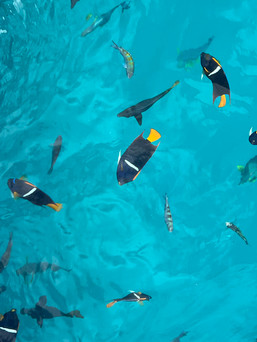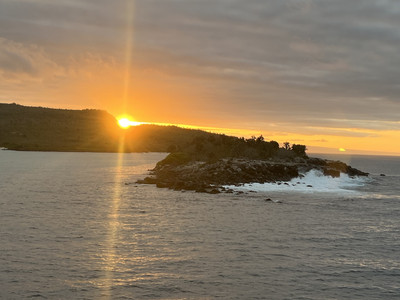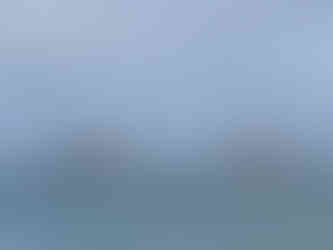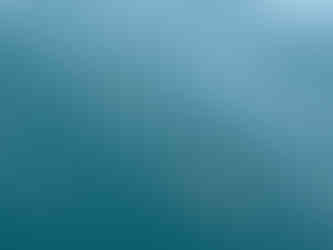The Galapagos
- bstclair579
- May 28, 2024
- 9 min read
To someone like me, visiting the Galapagos is incredibly special. As a forest geneticist, I spent my career trying to understand plant adaptation, how plants vary across the landscape, and the result of both natural and human selection on that variation. As a graduate student, I was quite enamored with my history of biology classes and read both the Origin of Species and the Voyage of the Beagle by Charles Darwin. I named my first dog as an adult after Darwin's friend and defender, Thomas Huxley (known as the bulldog of Darwinism). Visiting the Galapagos and seeing the results of natural selection on the different islands was truely a dream come true.
It was a last-minute decision to visit the Galapagos. I expected to get only a 10-day visa for Ecuador due to their restrictions for land border crossings because of the security situation. So I expected to drive quickly through Ecuador. But when I received a 90-day visa, I began to think about seeing the Galapagos. Previously, Sheri and I had discussed returning to visit there. Fortunately, Sheri was supportive of me going on my own (one of the reasons I love her). So on Thursday, May 9th, I booked a flight and an 8-day, 6-night cruise. Less than 24-hours later, I found myself on a small cruise ship with 13 other passengers, a naturalist guide, and a crew of seven. Sheri would have loved it, especially all the incredible snorkeling, and I promised her that someday we would return.
The cruise ship was the Fragata. It is an older ship (built in 1989) with some beautiful woodwork and plenty comfortable enough. I shared a cabin with a very nice guy from Stuttgart, Germany, named Carsten. We got along very well. The passengers included Joergen and Gabi, also from Germany. They were the first overlanders I met on my trip when I was at a campground just outside of Oaxaca City, Mexico. I ran into them again at Finca Sommerwind. Great folks. They have been on the road in their Sprinter RV for about three years (including time in the U.S. during Covid). The other passengers included: Kobian and Luisa from Dusseldorf, Germany; Ronan and Clare from Dublin, Ireland; Kevin and Giorgia from San Pablo, California (and Rome, Italy, UC Berkeley alums); Cole and Monika from Sacramento, California (and Salt Lake City); Anita from Vienna, Austria; and Alex from London, UK. Everyone except Joergen and Gabi were younger (about 30 years-old plus or minus a few years) and had started their professions, although most were taking some time off to travel in South America. It was a great group of folks and I truely enjoyed hanging out with them for a week.
Our guide was Jorge Espinosa. He was very knowledgeable and a good guy. He grew up on Santa Cruz Island. His father came to the Galapagos in 1959 to farm and later was a boat-builder. To be a resident and work in the Galapagos, you have to have some roots there (or through marriage). My impression is that becoming a guide is quite challenging and requires lots of training. I thought Jorge was a great guide.
Warning: I have many, many pictures of this wonderful trip. I tried to pare it down a bit, but still this blog is a long one.
Unfortunately I do not have any pictures of the underwater sealife. We went snorkeling once or twice everday and saw some incredible reef fish, four species of sharks, four species of rays, sea lions, turtles, grazing marine iguanas, and swimming penguins. Carsten took some wonderful videos while snorkeling - very fun to see. The snorkeling was excellent with good visibility in most places. The Galapagos is one place where the snorkeling may be almost as good as the diving. I very much enjoyed diving down and swimming among the large schools of fish. And swimming with sharks, rays, sea lions, and penguins. We also went on one or two nature hikes everyday and learned a lot about the birds, wildlife, plants, geology, and history of the islands. After each excursion, we would return to the ship and be greeted by the crew with snacks and juice or tea. Each evening before dinner, Jorge would give us a preview of what we would do and see the next day. Below are the pictures from each day.
Day 1: Arrived at airport on Baltra Island. Afternoon at Playa Las Bachas on Santa Cruz Island.
The first day I caught my flight from Quito to the Galapagos at 7:00 am. It was very confusing at the airport trying to figure out where to go and what fees to pay. I stood in one line for a long time, but then they said I had to check in first, so I went to check in, and they said I needed to go back to the other place and pay a fee before checking in. Back and forth, I barely made the flight. But fortunately I made it and was on our boat by noon.
We first went to a nice beach on Santa Cruz Island. Did a short walk with our guide, then some snorkeling, then back to the boat, a beautiful sunset, a welcome party to meet fellow passengers and crew, then headed to Genovesa Island during the night.
Day 2: Genovesa Island
We were incredibly fortunate to be able to visit Genovesa Island. It had been closed for five months due to an outbreak of avian flu. But we found out the day before that it would be open. So we were the first tourists to visit Genovesa in months. And what a special place.
We first took the pangas to a set of stairs called Prince Philip's Steps. On the way we saw some Galapagos fur sea lions, much rarer than the more common Galapagos sea lions. Climbing the stairs to the flat plateau of the island was like stepping into another world. Birds everywhere. Great frigatebirds puffing out their red throats. Nazca and red-footed boobies nests in the trail, some with newly hatched chicks. Red-billed tropicbirds. Swallow-tailed gulls. Walked to the other shore of the island looking for short-eared owls, but did not find any. After our hike, we went snorkeling along the side of the cliff. Beautiful clear water with a large variety of fish. Wow.
In the afternoon we went to the other side of the cove and went snorkeling to see hammerhead sharks. I saw one when we first went in the water. We also saw a manta ray.
After snorkeling we went to a small beach and did a short nature walk. A highlight was the sea lion "kindergarten" and watching the young sea lions play with each other.
Back to the boat, briefing, dinner, then head to Bartolome Island during the night.
Day 3: Morning at Bartolome Island. Afternoon at Sullivan Bay on Santiago Island
The highlights of the next day was mostly geological - and Galapogos penguins. We started with a panga (i.e., zodiac) ride to see the penguins. They are the second smallest penguin species, and the furtherst north. We then landed on the island and did a great hike to the top of a volcanic cone. Beautiful views. Back to the ship, into the pangas, and some snorkeling around the other side of Bartolome Island. Saw some white-tipped reef sharks.
After lunch we went to Sullivan Bay on Santiago Island. Sullivan Bay is an extensive lava flow of pahoehoe lava that formed near the end of the 19th century and start of the 20th century. The lava formations are very cool (now). After a nice hike on the lava, we went snorkeling where we got up close and personal with some green sea turtles.
Day 4: Morning at South Plaza Island. Afternoon at Santa Fe Island.
On the agenda the next morning was South Plaza Island just east of Santa Cruz Island. Nice hike around the island where we saw many fascinating land iguanas, sea lions, birds, and a project to restore the large cacti there. Then a two-hour boat ride to Santa Fe Island where we did some snorkeling followed by a nature hike. We enjoyed a large group of sea lions lazing around on the beach.
While visiting with Jorge the evening before, he asked how old I was and I mentioned that I just had a birthday. After dinner, the crew surprised me with a birthday cake and everyone sang Happy Birthday to me. After dinner, Cole entertained us with some amazing magic tricks. I was quite touched. It was so nice.
Day 5: San Cristobal Island. Morning at the beach and pango excursion at Cerro Brujo and Leon Dormido (Kicker Rock). Afternoon at Isla Lobas, then to Puerto Baquerizo Moreno for sunset.
The next day was spent at San Cristobal Island. We saw our first blue-footed boobies and marine iguanas, two species that are iconic for the Galapagos. We explored some nice rock formations around Cerro Brujo including an arch that leads to the bay where the Beagle first anchored. Returning to the boat, we sailed to Leon Dormido, also known as Kicker Rock. On the way there we saw numerous turtles swimming in the open sea, as well as a couple sunfish. After lunch we went snorkeling at Isla Lobos where we got up close and personal with some sea lions that appeared to be performing for us. Not sure who was watching who. After a short hike, we headed to Puerto Baquerizo Moreno, the capital of the province. Enjoyed a stroll around town, bought Henry a blue-footed boobie, and enjoyed some good beer at a brewery with my boatmates. After dinner it was off to Espanola Island during the night.
Day 6: Espanola Island. Morning at Punto Suarez. Afternoon at Gardner Bay.
Espanola Island was also closed the last five months because of bird flu, but had just reopened for tourists. Espanola has a lot of great things to see, so, again, we were quite lucky. It was nesting season for the waved albatross. It was fun watching them court, as well as coming in for a landing or taking off the cliff. There's also a really nice blow-hole on the south shore. And lots and lots of marine iguanas.
In the afternoon we went snorkeling around a small island in Gardner Bay followed by some time on the beach and more snorkeling from the beach. On to Floreana Island during the night. A highlight of traveling at night on the boat was sitting on the top deck and looking at the stars. We could always tell the directions we were heading because the Southern Cross and Ursa Major pointed the way.
Day 7: Morning at Floreana Island, Punto Cormorant and snorkeling at Devil's Crown. Afternoon at Santa Cruz Island, Puerto Isidro Ayora. Visit the Charles Darwin Research Station.
We were up early to take a nice hike on Floreana Island. The times that different boats are scheduled to land on the islands is strictly timed so that not too many people are visiting an island at once. The Galapagos has many restrictions, which is a great thing. You cannot wander off of any paths, or approach the wildlife too close. But the wildlife often sit right in the trail, and they are very tame, so there is no need to get any closer.
So we were in the pangas and hiking around sunrise. Watched a pelican fishing in the waves and saw some flamingos in a lake on the island. After our hike, it was back to the boat, grab our snorkeling gear, and headed to a nice formation called Devils Crown for snorkeling. We say hammerhead sharks, white-tipped sharks, and a Galapagos shark as well as sting rays and eagle rays. Beautiful schools of fish. Then back to the boat for breakfast.
Then it was four hours of smooth sailing to Puerto Ayora on Santa Cruz island. Puerto Ayora is the main town in the Galapagos. It is the location of the park headquarters and the Charles Darwin Research Station, a private institution that does research on the Galapagos and contributes to the conservation of the islands. One of their tasks is breeding of the Galapagos land tortoises. We visited the research station and saw the land tortoises. A famous tortoise was Lonesome George. Lonesome George was a tortoise from Pinta Island who was the last of his subspecies. He was found in 1971 and moved to the research station, where he was cared for until his death in 2012. He became an important symbol for the conservation of the Galapagos Islands. His taxidermied body is preserved at the station in a special climate-controlled room. It was actually quite moving for me.
Day 8: Last day. Morning at North Seymour Island. Back to the airport and flight to Quito.
Our last day was a short day. We got up early again to visit North Seymour Island. Quick hike around the island, then back onboard for breakfast before heading to Baltra and the airport. I had a bit of a wait at the airport, so enjoyed some pizza and a beer with Chuck.
What a wonderful trip. A spiritual experience for me. A life highlight. And a great group of folks to spend a week with.
Pictures of the friends from the week on board the Fragata: Gabi and Joergen, Kobian and Luisa, Clare and Ronan, Monika and Cole, Alex, Anita, Kevin and Giorgia, Carsten
Some of the crew: Jorge, Captain William, Alejandro, Miguel, Jimmy
List of some of the species seen:
Galapagos sea lion
Galapagos fur seal (sea lion)
Galapagos tortoises
land iguanas
marine iguanas
lava lizards
green turtle
Galapagos penguins
blue-footed boobies
red-footed boobies
Nazca boobies
waved albatross
great frigatebird
magnificent frigatebird
red-billed tropicbird
storm petrel
swallow-tailed gull
lava gull
brown pelican
American oystercatcher
plover
American greater flamingo
striated heron
green heron
lava heron
cattle egret
Galapogos mockingbirds
Darwin finches
yellow warbler
Golopagos hawk
Galapogos dove
scallped hammerhead shark
white-tipped shark
black-tipped shark
Galapagos shark
manta ray
spotted eagle ray
whiptail sting ray
golden cowray
yellowtail surgeonfish
king angelfish
giant damselfish
parrotfish
rainbow wrasse
Moorish idol
sargeant major
Mexican hogfish
trigerfish
blue-and-gold snapper
pufferfish
grunts
trumpetfish
giant trevally
sunfish (mola mola)
























































































































































































































































































































































































Wow! Just wow!
This might be my favorite post yet- Love the photos of the pahoehoe lava flows! Happy belated birthday, Brad!